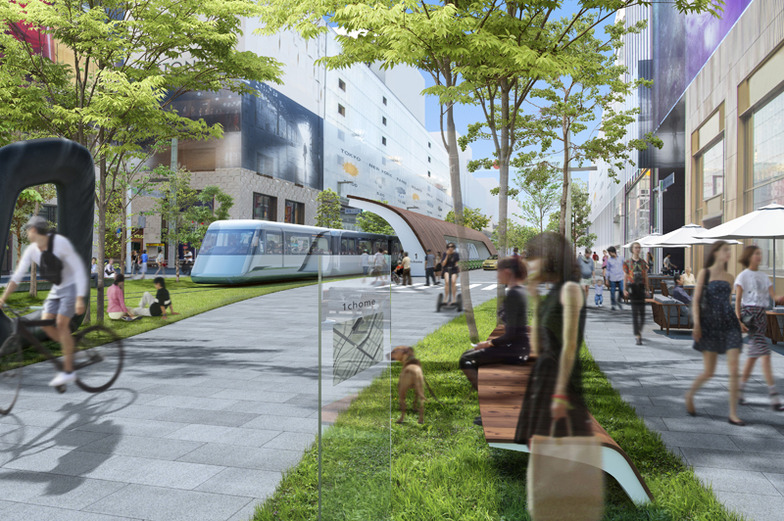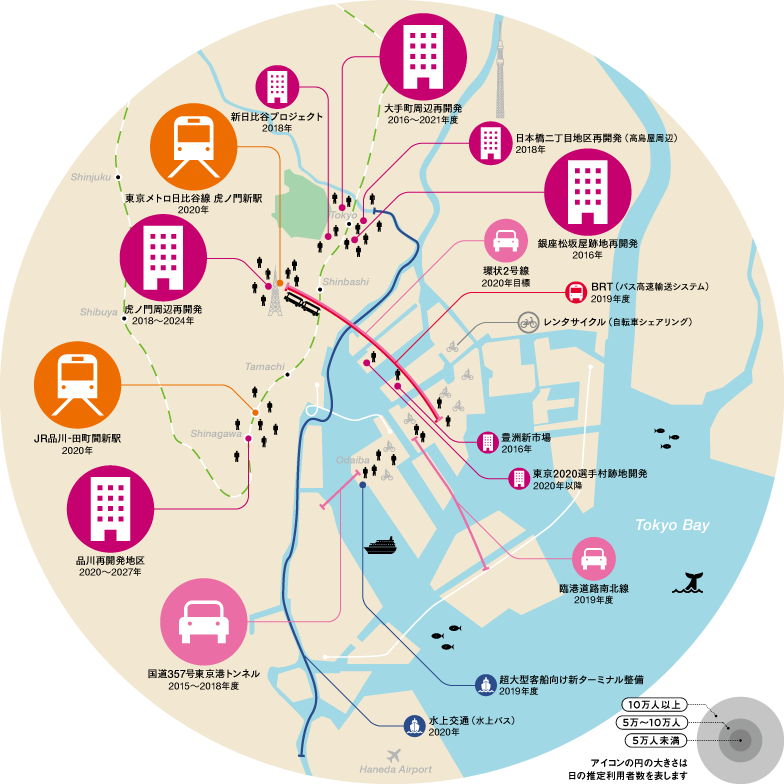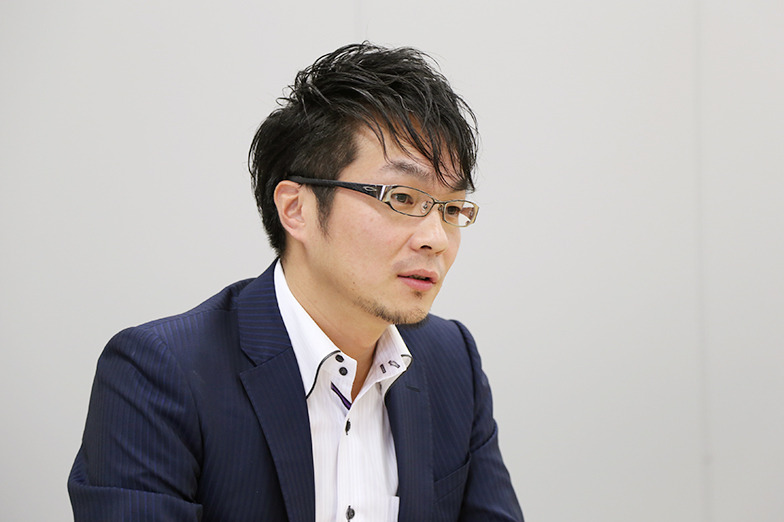Introducing BRT on the Circular Route 2,
smoothing travel between Toranomon and the waterfront area
Shimizu: As an urban development specialist, Mr. Sugimoto has been involved in various projects. How will Tokyo transform as we approach 2020? The coastal areas, in particular, are said to undergo significant development.
Sugimoto: Development in the waterfront area stalled somewhat after the 1995 Urban Expo was canceled. With Tokyo 2020, it's regained attention as it will serve as a major Olympic venue. Related projects are accelerating, such as the new Toyosu market, the expansion of Tokyo Big Sight, and private apartment construction. Essential to this is transportation infrastructure: the Ring Road 2 will connect Toranomon Hills to Shimbashi, Shiodome, Kachidoki, Harumi, Toyosu, and Ariake. Furthermore, they plan to implement a BRT system along this route. BRT stands for Bus Rapid Transit, a high-speed, mass-transport system based on buses. To avoid delays caused by traffic congestion, it prioritizes green lights at traffic signals and establishes dedicated lanes. Furthermore, using articulated buses enables high-capacity transport.
Shimizu: So it's specialized for smooth transfers, enabling people to flow quickly to the coastal areas.
With the opening of new stations and other developments, this impactful project will see over 100,000 daily users.
impactful developments
Shimizu: I think the opening of new stations will significantly alter people's movements and flow. New stations are planned for Shinagawa and the Toranomon area, which will serve as a BRT terminal. How exactly will things change?
Sugimoto: Shinagawa has a major redevelopment plan on the Takanawa side of the station. Additionally, around the new station planned between JR Shinagawa and Tamachi stations, commercial, residential, and office development is also advancing. With over 100,000 people using it daily, this will be a highly impactful development. It's the first new station on JR's Yamanote Line in about 50 years, since Nishi-Nippori Station opened in 1971.
In Toranomon, the Tokyo Metropolitan Government and Minato Ward are creating a new town centered around the Circular Route 2 (Shintora-dori) as a vibrant, green symbol street. They are also planning to build a new Toranomon Station on the Tokyo Metro Hibiya Line, which runs near Toranomon Hills, to improve accessibility.
Shimizu: It seems this series of developments—BRT, Ring Road 2, and the new stations in Shinagawa and Toranomon—are closely intertwined, leading to strengthened access routes to the waterfront area.
Sugimoto: Previously, Tokyo had areas where regions weren't well connected by roads. This time, connecting Tokyo with a ring line and creating a road that runs through the coastal area will link Toranomon to the Athletes' Village and the new Toyosu Market. On top of that, the new BRT transportation system will be implemented. I think it's a very innovative development.
Naming rights support public transportation operations
Shimizu: I believe various public services will continue to develop going forward, and I think there's potential for advertising to contribute to this. For example, in London, we saw cases where introducing naming rights led to the creation of new public services like bike rentals, cable cars, and water buses. What are your thoughts on that aspect?
Sugimoto: London's bike-sharing system really stands out when you're walking around the city. The futuristic design of the bikes contrasts with the historic streetscape. Plus, the height of the ads on the bikes puts them right at eye level. Since they're moving, I think they're quite effective as advertising. Also, bike-sharing struggles to be financially viable solely on user fees. Advertising revenue helps cover part of that cost. It creates a structure where naming rights underpin new public transportation ventures.
Ropeways also utilize naming rights. Designed as an impactful new mode of transport, they are planned to be linked with development projects across the Thames. The naming rights fee amounts to approximately 6.7 billion yen over 10 years, supporting the project's profitability. The same applies to the water bus. Public transportation is used daily, offering significant exposure opportunities. It's effective as advertising and can support public transport projects that struggle to be financially viable, creating mutual benefits.

London's Bike-Share System
Water Bus, Rail, and Bicycle Rental for Modal Mix
Shimizu: In London, I get the impression that the modal mix of land, sea, and air transportation has progressed quite well. How about in Tokyo?
Sugimoto: I believe the concept of modal mix—using public transportation wisely in combination—is necessary in Tokyo too.

What is Modal Mix?
For example, water transport was a vital means of transportation in Tokyo since the Edo period. However, it hasn't been used much recently. Waterfront spaces are becoming more accessible and their landscapes are improving, so Tokyo is reevaluating how to utilize them.
Shimizu: There's also a plan connecting Haneda to Nihonbashi.
Sugimoto: It would be a water bus. It could connect Haneda Airport to Nihonbashi in just 40 minutes without traffic congestion, and since it passes under the Rainbow Bridge, it would also offer sightseeing. It would allow foreign visitors arriving at Haneda to experience Tokyo from a maritime perspective, while also being quick. Eventually, it would be great if you could check into seaside hotels like those in Odaiba via water bus. I think it has the potential to become this new style of transportation.
However, water buses currently lack seamless connections with other transport modes. For instance, there aren't many stations near the piers. That's why I think there's a need to link stations and water buses using services like rental bicycles. You get off the train, rent a bike at the station, ride it directly to the water bus, then after disembarking, cycle back to the station and catch your train. It's truly a modal mix, a new form of transportation rarely seen elsewhere in the world. Similarly, if personal mobility devices could be used between train stations and water buses, it would make touring places like Odaiba or the Olympic venues easier and more senior-friendly.

A New Approach to Transportation Through Modal Mixing
Shimizu: Rather than developing areas point by point, it's about effectively connecting them along lines—the design of the entire transportation network becomes crucial, wouldn't you say?
Tokyo will become a showroom attracting foreign demand
Shimizu: It's easy to imagine the city becoming very livable with improved transportation networks and new commercial facilities. But the key perspective is how to preserve this as a legacy following Tokyo 2020.
Sugimoto: Back in 1964, infrastructure like the Metropolitan Expressway, Shinkansen bullet trains, and Tokyo Monorail were built. They remain vital infrastructure today. At that time, Japan was still an emerging nation. These projects were created to fuel its rapid economic growth and showcase it to the world – it was an inward demand-driven model.
For Tokyo 2020, Japan is a mature nation. This means we need an external demand-driven model to attract foreign investment, rather than relying solely on domestic demand. The key perspectives are attracting investment into Japan and promoting Japan's infrastructure and services globally.
Take hydrogen energy, for example. Clean hydrogen, produced without CO2 emissions using solar panels on building rooftops, could power buses or serve as energy for homes and offices. Connecting these separate applications through hydrogen creates a package: a "hydrogen city" that integrates power supply for streets and offices with transportation. I believe this waterfront subcenter could serve as a showroom, exporting Japan's technology and services.
Shimizu: So packaging the "hydrogen city" concept could become one of the measures to attract foreign demand.
Sugimoto: Beyond that, as a lasting legacy, I envision creating people-centered spaces and introducing systems like LRT (next-generation light rail transit) for easier mobility. Road space is the most usable shared public space for everyone. Can't we utilize it more effectively?
The image below transforms road space from being car-centric to people-centric. Once the Metropolitan Area's three ring expressways are completed, cars with no business in the city center can detour. This makes it easier to reallocate road space from cars to people-centric use. Furthermore, introducing LRT would eliminate the need for the elderly to climb stairs and is environmentally friendly. This space could feature open cafes, rental bicycles, and connections to new forms of personal mobility. Such a space would create a city more welcoming to families and the elderly, further enhancing its appeal.
Shimizu: It would be great if Tokyo 2020 became the catalyst for leaving such a legacy.

Image graphic of a future downtown with LRT
If we tackle this as a whole Japan effort, the legacy will remain in regional areas too
Sugimoto: While Tokyo is currently in the spotlight for Tokyo 2020, Japan has 47 prefectures. We hope this serves as an opportunity for visitors from overseas to also explore regional areas, experience the delicious local cuisine and unique cultures, and discover industries that can compete globally. By approaching Tokyo 2020 as a united Japan, I believe it's crucial that regional areas also join in projecting themselves to the world.
Shimizu: Thank you for your very insightful comments.










